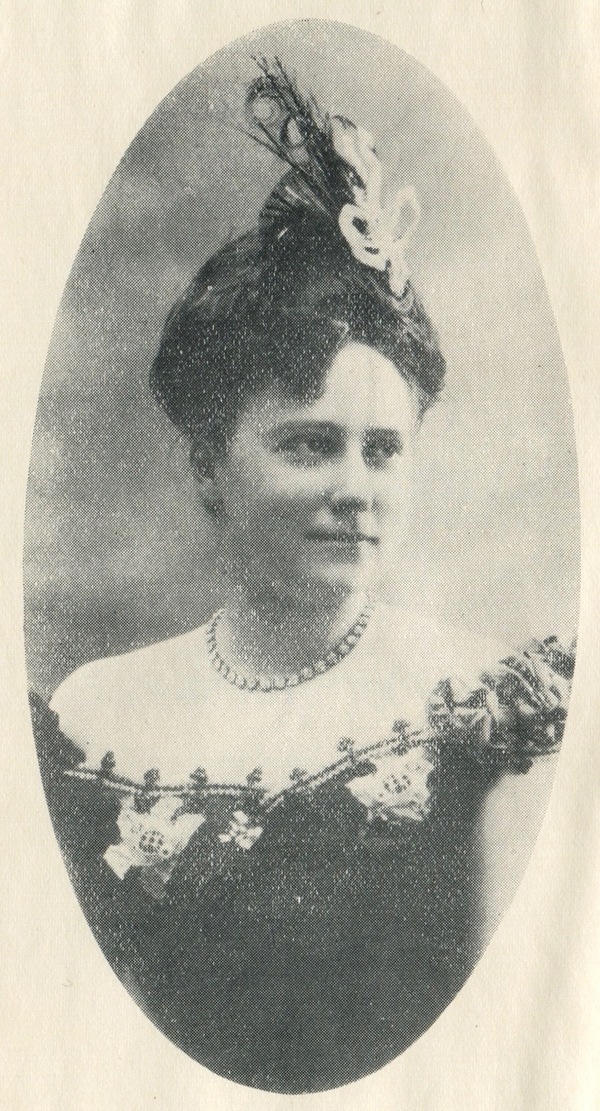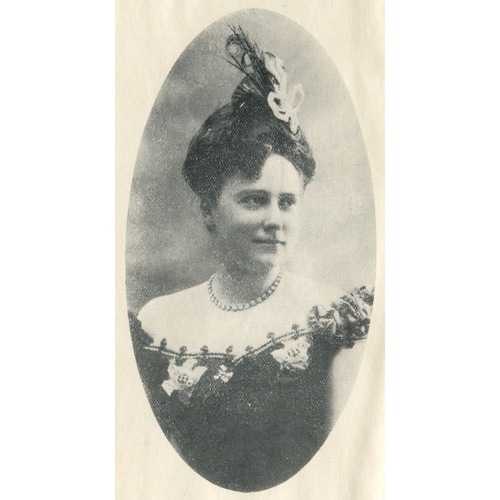
Source: Link
MARMETTE, MARIE-LOUISE (baptized Marie-Louise-Joséphine-Esther-Eliza) (Brodeur), known as Louyse de Bienville (she also used the pseudonym Domino Noir), author and lecturer; b. 29 March 1870 at Quebec, daughter of Joseph-Étienne-Eugène Marmette and Marie-Joséphine Garneau; m. 6 July 1892 Donat Brodeur (d. 1920) in Ottawa, and they had three sons and five daughters, one of whom died in infancy; d. 2 May 1928 in Montreal.
Marie-Louise Marmette, the only surviving child of the four born to her parents, came from a literary family. The historian François-Xavier Garneau* was her maternal grandfather; her father was a prolific writer who, in 1884, helped found the Cercle des Dix, an Ottawa literary society. Indeed, it was the title of one of the latter’s novels, François de Bienville, published in Quebec the year she was born, that inspired Marie-Louise to adopt the pen-name she would use most frequently, Louyse de Bienville. In later life she recalled that, when she was still a child, her father had taken her with him to several Quebec literary salons.
Schooled by the Ursulines in Quebec from 1880 to 1882, Marie-Louise was then taught by the nuns of the Congregation of Notre-Dame in Ottawa. She is also thought to have studied literature in Paris, where her family was obliged to make several stays on account of her father’s position as an archivist for the federal government. According to her daughter Marguerite, Marie-Louise spent four years in all in the City of Light and thus developed a fondness for French culture. In the summer of 1892, in Ottawa, she married Donat Brodeur, a lawyer. They would subsequently settle in Montreal and have eight children.
Marie-Louise pursued a literary career that is still little known in detail. Between 1902 and 1909 she wrote articles for the Journal de Françoise, a Montreal newspaper founded by Robertine Barry*, who was known as Françoise; they were probably among her earliest contributions to periodicals. This association with the women’s press in Montreal continued between 1913 and 1915 in the pages of Pour vous mesdames, a magazine founded and run by Georgine Bélanger*, who wrote under the name Gaétane de Montreuil. From 1913 to 1916 Brodeur also published articles in La Bonne Parole, the organ of the Fédération Nationale Saint-Jean-Baptiste, in which she was active. In particular she gave lectures at the monthly meetings of the Association Professionnelle des Employées de Manufactures and the Association Professionnelle des Employées de Magasins [see Marie-Anne Laporte], organizations that were sponsored by the federation. In 1920 and 1924 two pieces she wrote appeared in La Revue moderne, the journal whose editor was Anne-Marie Gleason*, known as Madeleine. At the same time, Brodeur published articles in newspapers of more general interest, including Le Temps of Ottawa, the Montreal paper Le Pays, Le Courrier de Montmagny, and Quebec’s Le Soleil. But she would never publish a book.
Brodeur tried her hand at various literary genres, including newspaper columns on current affairs and literature, biography, novellas, short stories, and poetry. While fascinated by the great figures of the past (from Joan of Arc to her ancestor François-Xavier Garneau), she also occasionally wrote about the state of Canadian literature, as well as about the advent of feminism, which was “one of the developments – the most important – that do honour to humanity,” as she noted in Pour vous mesdames in October 1913. Always an avid follower of current affairs, she was interested in World War I, partly, of course, as a mother – her three sons having enlisted – but also as a journalist who published several “Pages de guerre” in Pour vous mesdames in October 1914 and La Bonne Parole in February, March, May, and June 1916. Filled with admiration for the courage shown by the women of France during this struggle, she declared in June 1916 that “a nation made more glorious by such women will never be conquered.” When a daily column in La Presse invited opinions on the issue of female suffrage, on 18 Jan. 1919 Brodeur unequivocally demanded that women be accorded the right to vote, as well as “its liberal use.”
Despite a distinguished career that lasted almost 25 years, Marie-Louise Brodeur has not enjoyed the ongoing fame of a Françoise or a Madeleine. The fact that her writing is scattered in various periodicals doubtless helps account for this neglect. After her death, her daughter Marguerite collected about 30 of her pieces and published them as a book entitled Figures et paysages (Montréal, 1931). By this posthumous volume, announced as the first in a series of four, she hoped to pay a well-deserved tribute to her mother. Unfortunately for the historian, there were no further volumes.
[The author has compiled a complete list of the articles by Marie-Louise Marmette that appear in Le Journal de Françoise, Pour vous mesdames, La Bonne Parole, and La Rev. moderne, all published in Montreal. It is not exhaustive with respect to La Bonne Parole because the author was unable to consult the first volume. A copy of this list is available at the DCB. l.g.]
ANQ-Q, CE301-S1, 29 mars 1870. Le Devoir, 3 mai 1928, 21 mai 1932. BCF, 1923: 243. Georges Bellerive, Brèves apologies de nos auteurs féminins (Québec, 1920). DOLQ, 2: 493–94. Madeleine [A.-M.] Gleason-Huguenin, Portraits de femmes ([Montréal], 1938), 65. Hamel et al., DALFAN, 946–47. J. Hamelin et al., La presse québécoise, 4: 347. Roger Le Moine, Joseph Marmette, sa vie, son œuvre, suivi de “À travers la vie, roman de mœurs canadiennes” de Joseph Marmette (Québec, 1968). Mariages de la paroisse Sacré-Cœur, Ottawa (1889–1975), Julien Hamelin, compil. (Ottawa, s.d.), 24. Gaétane de Montreuil [Georgine Bélanger], “Mme Donat Brodeur,” Pour vous mesdames, 1 (1913–14): 202–3. M.-E. Vézina, “In memoriam,” La Rev. moderne, 9 (1928), no 6: 17.
Cite This Article
Line Gosselin, “MARMETTE, MARIE-LOUISE (baptized Marie-Louise-Joséphine-Esther-Eliza) (Brodeur), known as Louyse de Bienville (Domino Noir),” in Dictionary of Canadian Biography, vol. 15, University of Toronto/Université Laval, 2003–, accessed January 20, 2026, https://www.biographi.ca/en/bio/marmette_marie_louise_15E.html.
The citation above shows the format for footnotes and endnotes according to the Chicago manual of style (16th edition). Information to be used in other citation formats:
| Permalink: | https://www.biographi.ca/en/bio/marmette_marie_louise_15E.html |
| Author of Article: | Line Gosselin |
| Title of Article: | MARMETTE, MARIE-LOUISE (baptized Marie-Louise-Joséphine-Esther-Eliza) (Brodeur), known as Louyse de Bienville (Domino Noir) |
| Publication Name: | Dictionary of Canadian Biography, vol. 15 |
| Publisher: | University of Toronto/Université Laval |
| Year of publication: | 2005 |
| Year of revision: | 2005 |
| Access Date: | January 20, 2026 |



